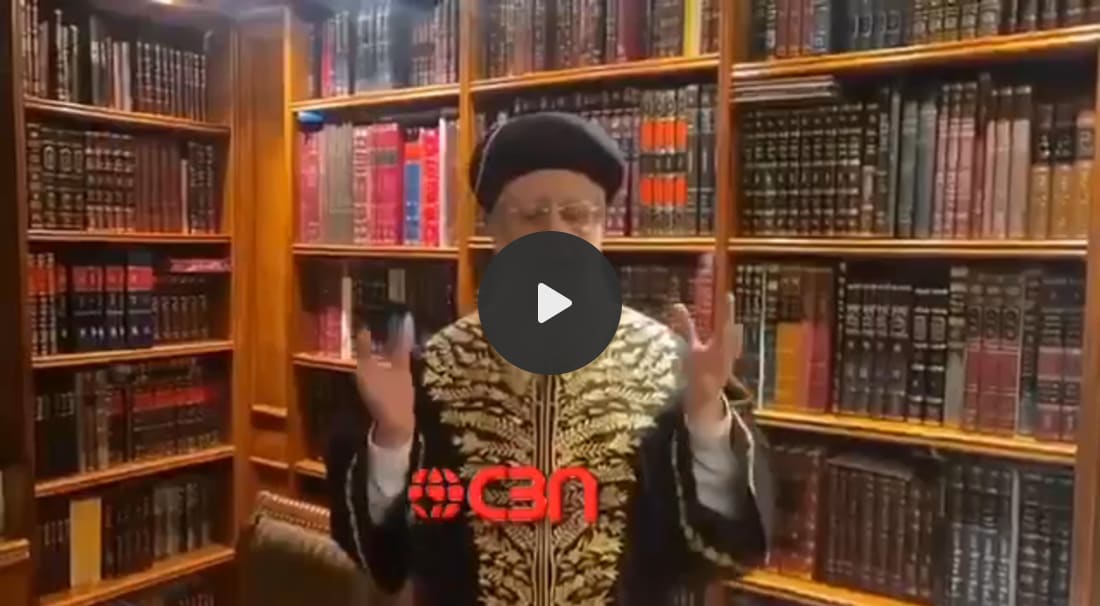Plus Rav Wasserman on 600 Jews Against 45,000 Zionist Hellenists
It’s truly remarkable how accurate his warnings turned out to be, and how timely his words remain nearly a century later.
The class is embedded above and on Rumble here.
For some reason it’s really hard for people to even consider the possibility that the Erev Rav regime would intentionally spread or even manufacture a measles scare for a larger nefarious purpose, as if such a thing is ludicrous and unprecedented. It’s not like some of their greatest heroes collaborated with the Nazis, after all.
Even those who still wish to deny the atrocities of the Covid era — which included murdering patients in isolation wards to promote fear, justify tyranny, and have all roads lead to their Molech injections — can no longer deny what they did to children decades ago, through the same “healthcare” system, and for which there has been no transparency or accountability.
Transparency and accountability are the most minimal first steps required for teshuva and restoring any measure of trust.
Here is Sephardic Chief Erev Rav David Yosef:
 If you want to know what a false prophet for hire looks like, I think this is a fine exhibit.
If you want to know what a false prophet for hire looks like, I think this is a fine exhibit.Yosef urges all parents to crapcinate their children for the measles Molech service, and says anyone who doesn’t is literally spilling blood according to Jewish law. He emphasizes this just so you don’t get the wrong idea that his inflammatory words, the likes of which could easily land someone in a dungeon if uttered without the approval of the state for whom he works, against the “wrong” demographic, are hyperbole.
Tell me, rabbi, if people are literally spilling blood by not injecting their children, does that mean we are allowed and even obligated to kill them?
I will remind people that, according to Chazal, one who is megaleh panim b’Torah shelo k’halacha, one who distorts the Torah to arrive at conclusions that contradict Jewish law, loses his share in the world to come — even if he has Torah and good deeds under his belt (Avos 3:11).
May God protect our children and vomit these revolting monsters out of our holy land without any further delay.
Back in 2024, when it was David Yosef’s brother’s turn to wear the ceremonial priestly garb, I wrote about the inherently corrupt Chief Rabbinate. The article is called Chief Rabbi of Israel: The Quintessence of Controlled Opposition (click on the link to read it).
The unit of the Military Rabbinate was created at the same time as the Israel Defense Forces in 1948. This unit works in cooperation with the Manpower Directorate. The Chief Military Rabbi, appointed by the Chief of Staff, is the highest religious authority in the IDF and advises the Chief of Staff on matters relating to religion. According to the law, a representative of the rabbinate must be present in each IDF unit. These representatives are in charge of all religious aspects according to the needs and traditions of the soldiers.
With the benefit of hindsight up to the present day, which has proven to be the true purpose of the Military Rabbinate?
We don’t even need to guess. The secular people who created, fund, and control the Military Rabbinate outline a list of duties and responsibilities. Notably, the extent of the authority of the rabbinate is to “issue recommendations and guidelines regarding religion in the IDF” and to “oversee the implementation” of whatever recommendations are actually approved.
But of course. You really expected a bunch of Bolsheviks to give their hired rabbis actual autonomy and authority? In their army, no less?
Zamir was born and raised in Eilat. His grandparents were immigrants from Yemen and Syria. He is a graduate of the 17th class of The Military Academy for Command in Tel Aviv. Zamir is a graduate of the Inter-Service Command and Staff College, and the National Security College. He holds a bachelor’s degree in political science from Tel-Aviv University, a Master’s degree in national security from the University of Haifa, and is an alumnus of the General Management Program for Senior Executives (GMP) of The Wharton School.
The IDF Rabanut has a YouTube channel with over 50,000 subscribers. If you browse the channel you will be hard-pressed to find anything even remotely rabbinic. The closest I found was a playlist of “halachic questions for army service” on matters of critical importance, such as making kiddush without wine. The answers are so deep and profound that they are all less than a minute long, with commercial music in the background.
I’m only aware of their channel because of a new video they put out that has been going around. Yesterday a close relative urged me to watch it, saying, “I know this is a propaganda, but it’s inspiring.”
Here is the video:
 I asked her what was inspiring about this video. Did it inspire her to do teshuva? To do more mitzvos? To learn more Torah? To serve Hashem better?
I asked her what was inspiring about this video. Did it inspire her to do teshuva? To do more mitzvos? To learn more Torah? To serve Hashem better? No, of course not.
It inspires the viewer to be proud of the IDF, to support the IDF, to believe the delusion that the IDF is a holy Jewish army fighting wars on the behalf of the Jewish people, and we should feel better about all these precious young Jews being maimed and killed.
That is the purpose of this video. And that is the purpose of the bulk of the videos on the IDF Rabanut’s YouTube channel. It is all propaganda, laced with kefirah, designed to get you excited about Jews in uniforms jumping up and down and dancing to pseudo-religious pop music.
Such as their most popular video, with over 11 millions views:
 The recurring theme of these music videos is not to be afraid, we are lions, the everlasting nation will not be defeated, and, let’s throw a bone, Hashem is with us.
The recurring theme of these music videos is not to be afraid, we are lions, the everlasting nation will not be defeated, and, let’s throw a bone, Hashem is with us.And don’t worry about the fact that Hashem being with us is contingent on many things, including an absence of vulgarity in the military camps, which drives away the shechina (Devarim 23:15). So what if you have thousands of women in the army where they don’t belong, and all sorts of improper behavior is de rigueur? Hashem doesn’t care! Jump up and down! Od yoter tov!
They don’t work for the soldiers. They don’t work for the people of Israel. They certainly don’t work for Hashem. They work for the people who hire and pay them, and they don’t work for any of the above, either — just the opposite.
But rest assured. One of the “responsibilities” of the Military Rabbinate is to provide every soldier with “a Bible during his or her IDF swearing-in ceremony.” I don’t know what heter there is for soldiers to swear, but I’m sure the rabbis worked that out.
And I don’t know why a “Bible” is sufficient without a Shas and a Shulchan Aruch as well, at the very minimum, but I suppose we shouldn’t indoctrinate new recruits with too much religion while they’re busy swearing body and soul to the IDF. It could get in the way.
They might not be excited about getting maimed and killed anymore. And that could lead to problems.
Unlike state-serving false prophets, my work isn’t artificially boosted, so please share it.






